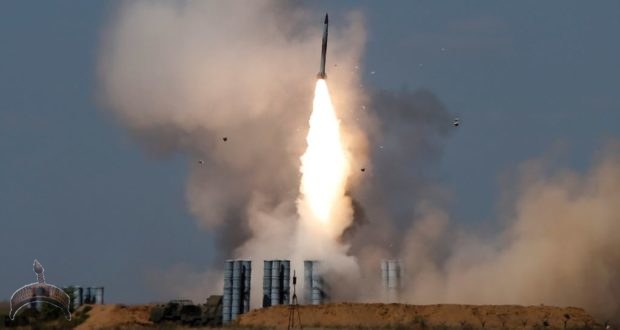We now know a little more about which version of the S-300 family the Russians have delivered to the Syrians: the Russians have converted a number of S-300PM and S-300P2 systems to the export version S-300PMU-2 “Favorit”which, by the way, is also the version Russia delivered to the Iranians and to the Chinese. This system uses the 48N6E2 missile and has an official range of 195km. I will skip the rest of the technical details and just say that this is a recent modification with excellent capabilities, so all the rumors about Russia delivering some antiquated version of the S-300 are now proven false (as usual). In fact, this is not the first time that the Russians have delivered an “Israeli-restraining” air defense system: in 1983 the USSR delivered a number of S-200VE “Vega-E” (SA-5b) air defense systems to Syria which significantly limited Israeli operations over and even around (AWACS) Syria.
Combined with the EW systems also delivered by Russia, these air defense systems clearly are having an impact on US and Israeli operations. And while the Americans are admitting that this is a problem for them, the Israelis, as usual, have both complained about this delivery and boasted that they did not care at all. adding that they would continue to bomb Syria whenever they feel the need. The Israelis have even declared that they would be willing to kill Russian crews if their aircraft are shot at. Except, of course, that so far the Israelis have stayed out of the Syrian skies (keep in mind that according to Israeli sources in 2017 the IDF attacked Syria over 200 times, roughly one attack every 2nd day!).
This time around, not only are the Israelis facing a much more competent air defense system, this system is also highly mobile and therefore much harder to locate, which will greatly complicate future attacks. Furthermore, since one S-300PMU2 battalion can track 300 targets (and engage 36 with 72 missiles simultaneously) at a very long range, the Syrians will now improve their early warning capabilities tremendously, which will make it much harder for the Israelis to successfully conduct surprise attacks against Syria.
Sooner or later, however, we can be pretty confident that both the Israelis and the US will have to try to strike Syria again, if only for PR purposes. In fact, this should not be too difficult for them, here is why:
First, and contrary to what is often claimed, there are not enough S-300/S-400’s in Syria to indeed “lock” all of the Syrian airspace. Yes, the Russians did create a de-facto no-fly zone over Syria, but not one which could withstand a large and determined attack. What the combined Russian and Syrian forces have done so far is to deny some specific segments of the airspace above and around Syria to the AngloZionist aggressors. This means that they can protect some specific, high-value targets. However, as soon as the US/Israelis get a feel for what has been deployed and where, and how this entire integrated air defense network works, they will be able to plan strikes which, while not terribly effective, will be presented by the propaganda machine as a major success for the AngloZionists.
Second, air defense operations are always a game of numbers. Even if you assume that each of the air defense missile has a probability of a kill of 1 (meaning that every air defense missile fired will destroy one incoming missile), you still cannot shoot down more missiles than what your own stores allow you to fire. The US/NATO/CENTCOM can, if needed, engage many more missiles in a saturation attack than the Russians have available for defense. This is unlikely to change in the foreseeable future.
Third, the US/NATO/CENTCOM/IDF all have advanced EW capabilities which will allow them to try to disrupt the Russian fire and reconnaissance capabilities, especially if low RCS aircraft (such as the F-22, F-35, B-1B, etc.) are used in the attacks. Low-RCS aircraft (and missiles) don’t have to operate alone and, in reality, they are often engaged with the support of a determined EW effort.
Finally, the Empire also has long-range weapons which could be used to strike Syria (such as the AGM-158 JASSM low-RCS standoff air-launched cruise missile), especially during a combined electronic warfare and standoff antiradiation missile attack.
So, all the AngloZionists really need to do is to be very careful in their choice of paths of approach and choice of targets, use low-RCS aircraft and missiles under the cover of a robust EW engagement and then use a large enough number of missiles to give the appearance that the Empire has defeated the Russian and Syrian air defenses.
Judging by their past attacks against Syria, the US and the Israelis are far more concerned with the need to appearvery powerful, effective and quasi-invulnerable than by actually achieving some meaningful military objective. Of course, this need to appear invulnerable also means that the AngloZionists really cannot afford to have one of their aircraft shot down, hence their current reluctance to test out the Syrian air defense capabilities.
Sooner or later, however, the Israelis will have to try to “defeat the S-300” as they would put it.
The problem for the Israelis is that they don’t really have any good options. The problem is not so much a technological one as it is a political one.
Let’s assume that the Israelis conduct a successful strike against a meaningful target (if their attack is symbolic, the Russians and Syrians can just limit their reply to the usual protests and denunciations, but take no real action). What would Russia do? Well, the Russians (Shoigu specifically) have already indicated that, if needed, they would increase the number of S-300 batteries (and required support systems) delivered to Syria. Thus, the main effect of a successful attack on Syria will be to make subsequent attacks even harder to plan and execute. Would that really be a desirable outcome for the Israelis? I don’t think so.
If each successful Israeli strike makes each subsequent strike even harder while increasing the danger for Israeli aircraft, what would be the point of such attacks? Are there any truly high-value targets in Syria whose destruction by the IDF would justify triggering a further degradation of the situation in Syria? Conversely, if you were Syrian (or Iranian), would you not want the Israelis to strike Syria (or even S-300 batteries) hard enough to force the Russians to deliver even more air defense systems (not necessarily S-300s by the way!)?
Just as with the case of Hezbollah in Lebanon (which the Israeli invasion of Lebanon in 1982 helped create), and the coming to power of Hassan Nasrallah at the head of Hezbollah (which the murder of Abbas al Moussawi by the Israelis in 1992 propelled to the position of Secretary General of the organization), the Israelis are re-discovering again and again the truism: while simple, brute force violence does appear to be effective in the short term, in the mid to long-term it always fails unless backed by meaningful political measures. The big axiomatic truth which the Israelis still are stubbornly refusing to recognize is that all true security is always collective (something the Russians have been repeating for years now). In the case of Syria, Israel would be much, much better off negotiating some kind of deal with the Russians, the Iranians and the Syrians (even an unofficial one!) than trying to prevail by blowing up targets in Syria.
I would even argue that with the Trump presidency now dramatically increasing the rate of collapse of the AngloZionist Empire the Israelis need to start making plans to involve other actors in their regional policy. The truth is that the US is not in a position anymore to remain a key player in Middle-Eastern politics and that decades of abject submission to the Likudnik agenda have irreparably damaged the US credibility and influence in the Middle-East (and the rest of the world).
I would compare the delivery of S-300PMU-2 “Favorit” batteries to Syria to a chess opening or an irreversible move like castling: it does not, by itself, decide the outcome of the game, but it does create a baseline environment in which both players will need to operate. For the Russians, the next step is quite obvious: to continue to deliver all types of air defense systems to the Syrians (especially more Pantsirs) with the goal of eventually being able to protect the entire Syrian airspace from any attacks by the US or Israel. The main elements of a multi-layered air defense network are already deployed, Syria now only needs larger numbers. I very much hope that Russia will provide them.
The Saker
 Ọmọ Oòduà Naija Gist | News From Nigeria | Entertainment gist Nigeria|Networking|News.. Visit for Nigeria breaking news , Nigerian Movies , Naija music , Jobs In Nigeria , Naija News , Nollywood, Gist and more
Ọmọ Oòduà Naija Gist | News From Nigeria | Entertainment gist Nigeria|Networking|News.. Visit for Nigeria breaking news , Nigerian Movies , Naija music , Jobs In Nigeria , Naija News , Nollywood, Gist and more









